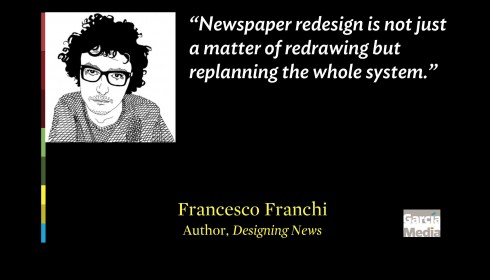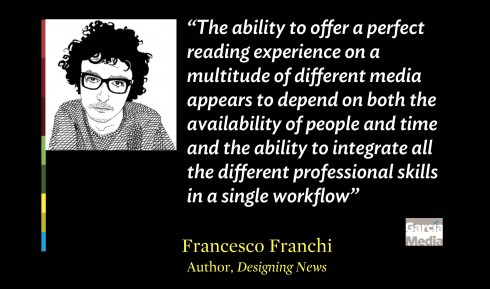This is the weekend edition of TheMarioBlog and will be updated as needed. The next blog post is Monday, November 18
TAKEAWAY: Francesco Franchi, author of the new book Designing News, talks to us about the future for media and the ideal profile of editors and designers who have the professional skills to take content and make it flow through different platforms.
A few days ago we reviewed Francesco Franchi’s new book Designing News and celebrated this new entry into the library of news and news design. Francesco is art director, Il Sole 24 ORE, in Italy.
At the time of the review, I asked Francesco a few questions that were fresh in my head the moment I finished reading his 240-page hardbound book, which abounds in illustrations, charts and explanatory texts.
Here is my interview with Francesco Franchi:
“Most interesting and ambitious time for a designer”

Mario
Your book is realistic, but also optimistic, about the challenges and opportunities that we in the media face today. On what do you base your optimism?
Francesco
I think this is the most interesting and ambitious time for a designer to be working in the newspaper market. There is a lot going on in the newspaper sector all over the world: a continuous series of redesign projects, as editors rethink their strategies, analyze what they are doing and how, and seek new solutions and new tactics. The advent of the tablet has also created a whole new market that remains to be discovered and invented.
I don’t think we have to be pessimistic. The death of the newspaper, often denied but much feared, may be avoided by adapting to the new circumstances. And to some extent, the change has already begun — tangible products made of paper newspapers are mutating to intangible services for knowledge. Design can play a strategic role in this transformation, but it can only be of value if it manages to capture the meaning of things.
Who are doing it best?
Mario:
In terms of digital: where in the world are you seeing the best examples of newspapers and magazines that have made the transformation to a multi platform media world successfully?
Francesco:
Apart from the New York Times, the Guardian and Reuters — which are some of the case studies described in my book Designing News, — many news organizations across the world are experimenting and innovating in digital.
Circa, for example, is a new app which aims to revolutionize how we get breaking news.Vox Media is developing beautiful longform storytelling; while Gawker Media is working in truly interactive news platform where readers should be able to contribute stories, get them on the front, determine headline and image size that their friends see, rebut stories, etc.
The Washington Post, which has just launched Topicly — a visual news platform which groups articles by theme and links them under an image in a grid, — and Al Jazeera are also companies to look at in the near future. New forthcoming startup companies are also trying to follow the success of Buzzfeed but focusing on niches.
What’s going to happen to printed newspapers, magazines?

Mario:
I especially enjoyed your chapter about Rethinking, and your approach to printed publications: where do you see printed newspapers and magazines, let’s say, 10 years from now?
Francesco:
The advent and popularity of the tablets — portable, small, easy to handle — have given publishers the incorrect impression that the transition from print to digital could be made by simply transposing the old content onto the new accessories, with just a few adjustments in size and a few multimedia additions to justify the change of platform.
In the latest chapter of my book, the re-thinker understands the transformations currently underway in the world of information, lives with the new technologies, adopts new languages (making the most of the opportunities offered by infographics), and seeks to implement a process of rethinking the entire system. The re-thinker brings a new epistemology of professional practice, not just implementing decisions made from above or coming up with a new graphic look but actively participating in the process of rethinking the whole experience of use, distribution, access, and ?sharing of content. Seen in this light, newspaper redesign is not just a matter of redrawing but replanning the whole system.
What next for tablets?
Mario:
Where will we be a few years from now with the content we put into tablets?
Francesco:
I do not think that the form which magazines and newspapers are assuming now through the tablets will be their form of the future. I think that it is still quite hard to reach the good balance, the rhythm and the attention to details in the tablet versions like we are used to see in print publications.
Tablets are good for long form reading, they are good for interaction, but editorial design goes further: it embraces journalism, it develops a journalistic idea and it is based on storytelling. It’s not a matter of how much interaction and special effects we can add throughout tablet versions to a magazine. The effort is to design interesting products starting from good journalistic ideas. An editorial concept can no longer be simply reduced to a “digital replica”. All aspects of content management, from creation to distribution, must reflect the concept to ensure that it is expressed in full.
Offering a grid for interpreting the world through a specific selection of stories is still important, but not as essential as it once was. Content, in fact, is increasingly free to flow and combine in new ways of reaching readers, who have more and more power to customize. Rather than offering a point of view, they suggest ways of managing knowledge and interacting with information. This is why the role of the designer must change. The importance of graphic identity, and even more, of visual storytelling, is not decreasing. To the contrary, managing to reconstruct a consistent reading structure that gets the reader involved without excluding opportunities to customize, socialize, break up stories and put them back together is one of the major challenges facing the new designers.
The storyteller of the future
Mario:
What type of storytellers will we need for what you are describing?
Francesco:
Translating an editorial idea into the new context requires professionals that are capable of analyzing reality through a holistic approach, capable of suggesting models of interpretation that first of all help to define the purposes of the publishing initiative and secondly set forth consistent working strategies.
At present, the ability to offer a perfect reading experience on a multitude of different media appears to depend on both the availability of people and time and the ability to integrate all the different professional skills in a single workflow, not viewing the different platforms as discontinuous elements but, on the contrary, working with them as integral parts of a single process. In an article in his blog (http://www.subtraction.com/2011/10/27/where-are-all-the-ed-ex- designers), Khoi Vinh (former digital design director of the New York Times) underlines the importance, in today’s new editorial panorama, of a new kind of designer whom he calls an “editorial experience designer” (ed-ex designer), a figure “who can build a great digital product out of great editorial content.” Bringing together these two sets of skills, which were until recently far removed in a single professional figure, requires an open and forward-looking overall vision and concept of design. The simultaneous presence of the two types of skills makes it possible to comply with the conventional principles of editorial design and user experience on the one hand, and go beyond them by innovating on the other. The years ahead of us will bring some exciting challenges. Learning to change is the most important thing we can do.
Our review of Designing News
https://garciamedia.com/blog/articles/pdesigning_news_a_new_book_about_transformation_p